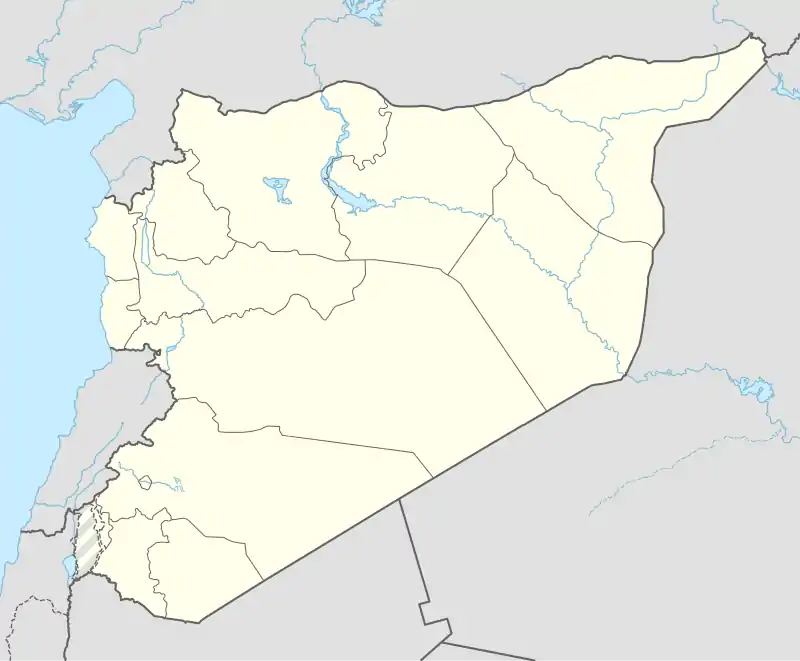Nawa, Syria
Nawa (Arabic: نوى, romanized: Nawā) is a Syrian city administratively belonging to the Daraa Governorate. It has an altitude of 568 meters (1,864 ft). It had a population of 59,170 in 2007, making it the 28th largest city per geographical entity in Syria.
Nawa
نوى | |
|---|---|
City | |
 Nawa Location in Syria | |
| Coordinates: 32°53′20″N 36°02′35″E | |
| Grid position | 247/255 PAL |
| Country | |
| Governorate | Daraa |
| District | 'Izra |
| Subdistrict | Nawa |
| Elevation | 563 m (1,847 ft) |
| Population (2007) | |
| • Total | 59,170 |
In antiquity it was the city of Neve in the Roman province of Arabia Petraea.[1]
History
Nawa has been identified as the city that Job dwelled in and the burial place of Shem, the son of Noah.[2] During the Roman and Byzantine era it had a large Jewish population.[3] The city is mentioned in the 3rd century Mosaic of Tel Rehov, and is also referred to by George of Cyprus ("Descriptio orbis romani", ed. Heinrich Gelzer, 54) in the 7th century.[1] Numerous basalt architectural members dating to the Byzantine period bearing Jewish symbols—most prominently the menorah—were discovered ire used as spolia within Nawa (A. Reifenberg, 'Ancient Hebrew Arts', 1952). Under the Islamic Caliphate of the Rashidun, Umayyads, and Abbasids, it was a part of Jund Dimashq and the principal city of Hauran. Al-Mas'udi wrote in 943 that a mosque dedicated to Job was located 5 kilometres (3 mi) from Nawa.[4] By the 13th century, its status declined; Yaqut al-Hamawi recorded in 1225 that Nawa was "a small town of the Hauran", formerly the capital of the region. In 1233, Imam Yahya ibn Sharaf al-Nawawi, a prominent Muslim scholar, was born in the city.[5]
In 1596 Nawa appeared in the Ottoman tax registers as Nawi and was part of the nahiya of Jaydur in the Hauran Sanjak. It had an entirely Muslim population consisting of 102 households and 43 bachelors. The villagers paid a fixed tax-rate of 40% on wheat, barley, summer crops, goats and/or beehives; a total of 26,000 akçe.[6]
In July 2018, the citizens of Nawa were subject to heavy Syrian government and Russian military bombardment, in an effort to rid the city from its anti-government forces.[7]
Ecclesiastical history
The bishopric of Neve (Nawa) was a suffragan of Bostra, the metropolitan see of Arabia Petraea. Two of its bishops are known:
- Petronius, who attended the Council of Ephesus in 431;
- Jobius, who was present at the Council of Chalcedon in 451.[1]
Isaac, mentioned by Le Quien as a third bishop, of about 540 (Oriens christiana, II, 864), was a bishop not of Neve but of Nineve, and lived at the end of the seventh century ("Échos d'Orient", IV, 11).[1]
The Diocese of Neve is noticed in the Notitia episcopatuum of the patriarchate of Antioch in the 6th century ("Échos d'Orient", X, 145).[1]
References
- Vailhé, Siméon (1911). "Neve". Catholic Encyclopedia. 10. New York.
- le Strange, 1890, p.516
- Midrash Rabba (Lamentations Rabba 1:60); Martin Goodman, Jews in a Graeco-Roman World, Clarendon Press: Oxford 2002, p. 70 ISBN 0-19-815078-4; Hüttenmeister and Reeg, Die antike Synagogen in Israel (vol. 1), Wiesbaden 1977, pp. 336–339 ISBN 3920153685; G. Schumacher, Across the Jordan (1866), pp. 167–ff.
- Le Strange, 1890, p.515
- Yahya ibn Sharaf al-Nawawi (d. 676/1277)
- Hütteroth and Abdulfattah, 1977, p. 207
- "Syrian city Nawa bombarded in deadly campaign after reconciliation talks fail". Associated Press. 18 July 2018. Retrieved 18 July 2018.
Bibliography
- Hütteroth, Wolf-Dieter; Abdulfattah, Kamal (1977). Historical Geography of Palestine, Transjordan and Southern Syria in the Late 16th Century. Erlanger Geographische Arbeiten, Sonderband 5. Erlangen, Germany: Vorstand der Fränkischen Geographischen Gesellschaft. ISBN 3-920405-41-2.
- Le Strange, G. (1890). Palestine Under the Moslems: A Description of Syria and the Holy Land from A.D. 650 to 1500. Committee of the Palestine Exploration Fund.
External links
- Map of town, Google Maps
- Naoua-map, 20L